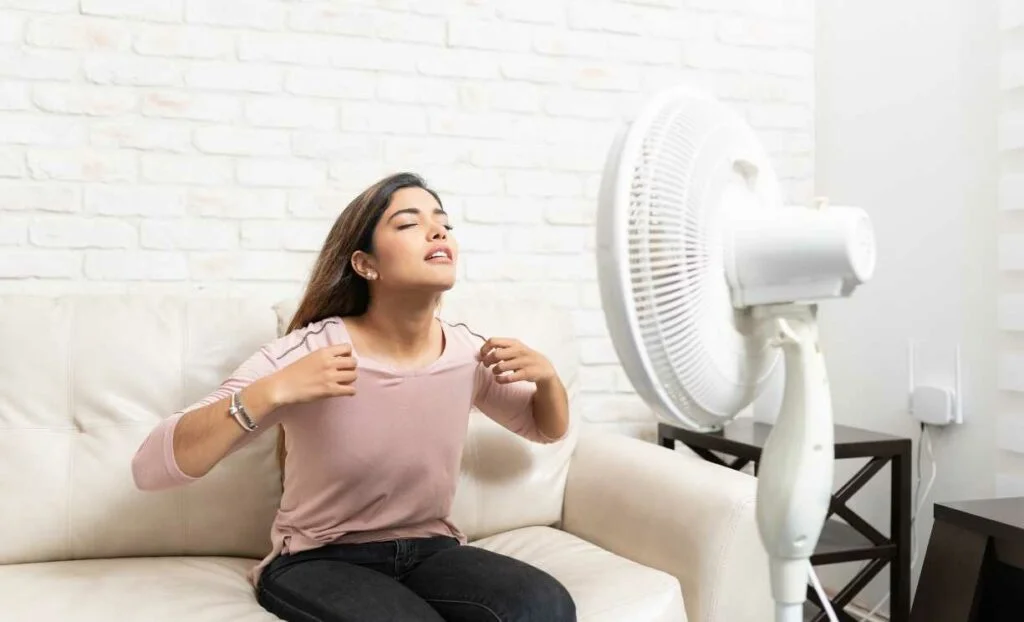Hot flashes, characterized by sudden feelings of heat, flushing, and perspiration, are a common symptom experienced by many, particularly women going through menopause. These episodes can be disruptive and affect daily life. In this blog, we’ll explore the various medicines available for managing hot flashes, shedding light on their mechanisms, potential side effects, and considerations to help individuals make informed decisions about finding relief.
Contents
Understanding Hot Flashes And Why They Occur
Hot flashes are a common and often perplexing experience, especially for women undergoing menopause. Simply put, they happen due to hormonal changes in the body. During menopause, a natural phase in a woman’s life, estrogen levels drop. This hormonal shift confuses the brain’s temperature control center, the hypothalamus. The hypothalamus perceives the body as too hot and initiates a response to cool it down.
This response includes dilation of blood vessels and an increase in heart rate, leading to the sudden sensation of intense heat, flushing of the skin, and sometimes perspiration—commonly known as a hot flash. While the exact cause of this hormonal miscommunication is not fully understood, it’s this disturbance in the body’s thermostat that gives rise to the characteristic warmth and discomfort associated with hot flashes during menopause.
Medicines For Hot Flashes
When it comes to managing hot flashes, several medications have shown efficacy in providing relief. Here are some commonly prescribed medicines for hot flashes:
- Selective Serotonin Reuptake Inhibitors (SSRIs): Medications like paroxetine, a type of SSRI commonly used to treat depression, have been found effective in reducing the frequency and severity of hot flashes. These drugs work on the brain’s neurotransmitters, influencing temperature regulation.
- Serotonin-Norepinephrine Reuptake Inhibitors (SNRIs): Venlafaxine, an SNRI often prescribed for depression and anxiety, has shown effectiveness in managing hot flashes. Like SSRIs, SNRIs influence the central nervous system to modulate body temperature.
- Gabapentin and Pregabalin: Originally developed to treat seizures and nerve pain, these medications have demonstrated efficacy in reducing hot flashes. They affect the central nervous system and help alleviate the perception of temperature changes.
- Clonidine: Typically used to manage high blood pressure, clonidine has been found to reduce hot flashes. Its mechanism in mitigating these symptoms is not fully understood but may involve its impact on the central nervous system.
- Oxybutynin: Originally designed to treat overactive bladder, oxybutynin has shown promise in reducing the frequency of hot flashes. It may impact the nervous system’s control over body temperature.
It’s essential to note that the choice of medication depends on individual health factors, preferences, and the severity of symptoms. Additionally, potential side effects and risks associated with each medication should be discussed thoroughly with a healthcare provider before starting any treatment regimen.
Some Other Treatment Options
The treatment options for hot flashes vary, and the choice depends on individual preferences, overall health, and the severity of symptoms. Here is a comprehensive overview of treatment options for managing hot flashes:
- Hormone Replacement Therapy (HRT): HRT is a widely used treatment for hot flashes, especially in menopausal women. It involves supplementing the body with estrogen, often combined with progesterone in women with a uterus. HRT helps balance hormonal levels and alleviate symptoms, but its use should be carefully considered due to associated risks.
- Biofeedback: Biofeedback teaches individuals to control physiological functions, such as heart rate and muscle tension, through electronic monitoring. It may help individuals gain better control over bodily responses, potentially reducing the frequency and intensity of hot flashes.
- Cognitive-Behavioral Therapy (CBT): CBT is a form of psychotherapy that helps individuals manage the psychological aspects of hot flashes, including stress and anxiety. It provides tools and coping mechanisms to navigate the challenges associated with these symptoms.
Individual responses to these treatment options can vary, and what works for one person may not be as effective for another. It’s advisable to consult with a healthcare provider to discuss individual symptoms, preferences, and potential interactions with existing medications before pursuing any specific treatment approach.
Lifestyle Changes For Managing Hot Flashes
Lifestyle changes play a crucial role in managing hot flashes, helping individuals navigate these episodes with greater comfort and control. Here are lifestyle modifications that can contribute to minimizing the frequency and severity of hot flashes:
- Regular Exercise: Engage in regular physical activity, such as brisk walking, swimming, or cycling. Exercise not only promotes overall health but also helps regulate hormonal levels and may alleviate the intensity of hot flashes. Aim for at least 150 minutes of moderate-intensity exercise per week.
- Cooling Techniques: Stay cool by using fans, wearing light and breathable clothing, and keeping the living and sleeping environments well-ventilated. Layering clothing allows for easy adjustment to changes in body temperature.
- Hydration: Stay well-hydrated by drinking plenty of water throughout the day. Adequate hydration helps regulate body temperature and can be beneficial during hot flashes.
- Balanced Diet: Adopt a balanced and nutritious diet rich in fruits, vegetables, whole grains, and lean proteins. Limit the intake of processed foods, spicy foods, and caffeine, as they may trigger or exacerbate hot flashes.
- Manage Stress: Practice stress-reducing techniques such as deep breathing, meditation, yoga, or tai chi. Chronic stress can contribute to the frequency and intensity of hot flashes, so managing stress is crucial.
- Quit Smoking: Smoking is associated with an increased frequency and severity of hot flashes. Quitting smoking not only improves overall health but can also positively impact menopausal symptoms.
- Layer Clothing: Dress in layers to easily adjust to changes in body temperature. This allows for quick cooling during a hot flash and warmth when needed.
- Regular Sleep Patterns: Establish and maintain regular sleep patterns. Lack of sleep or irregular sleep can contribute to hormonal imbalances and exacerbate hot flashes.
Alternative Therapies For Hot Flashes
Several alternative therapies offer potential relief for hot flashes, providing individuals with additional options to manage these symptoms. While individual responses vary, some people find benefit from the following alternative approaches:
- Herbal Supplements:
- Black Cohosh: Widely used for menopausal symptoms, black cohosh is believed to have estrogen-like effects. However, its efficacy is debated, and it should be used with caution.
- Soy Isoflavones: Found in soy products, these compounds mimic estrogen and may help alleviate hot flashes.
- Mind-Body Practices:
- Yoga: Incorporating yoga into a routine can promote relaxation and stress reduction, potentially helping manage the frequency and intensity of hot flashes.
- Meditation: Mindfulness meditation can contribute to emotional well-being and may help individuals navigate the psychological aspects of hot flashes.
- Acupuncture: Acupuncture involves the insertion of needles into specific points of the body. Some women find that acupuncture helps reduce the frequency and severity of hot flashes. The exact mechanisms are not understood but may involve balancing energy in the body.
- Chiropractic Care: Chiropractic adjustments may help support overall well-being and may have a positive impact. Some individuals report a reduction in the severity of hot flashes after chiropractic sessions.
- Aromatherapy: Certain essential oils, such as peppermint or lavender, may be used in aromatherapy to create a calming environment. While not a direct treatment for hot flashes, relaxation induced by aromatherapy may contribute to symptom relief.
- Dietary Changes: Some individuals experience relief from hot flashes by making dietary adjustments. Incorporating more plant-based foods and reducing the intake of processed or spicy foods may be beneficial.
- Massage Therapy: Massage therapy may contribute to relaxation and stress reduction, potentially helping manage the emotional aspects of hot flashes.
- Chilled Products: Using chilled products, such as cooling towels or gel packs, can provide immediate relief during a hot flash by lowering body temperature.
Conclusion
In conclusion, the journey of finding relief from hot flashes often involves a personalized approach that may include various medicines. The array of options, from hormone replacement therapy to SSRIs, SNRIs, and alternative therapies, offers individuals the opportunity to tailor their treatment plans to their unique needs and preferences. While medications can significantly alleviate the impact of hot flashes, it’s essential to consider lifestyle modifications and alternative therapies as complementary elements in this holistic approach.
As research continues to advance and new insights emerge, the toolbox for managing hot flashes expands, providing hope and solutions for those navigating this common yet challenging aspect of menopause.
If you are facing menopause-related issues, menopause treatment at HerMantra can help. Book your free trial online menopause treatment session now.





